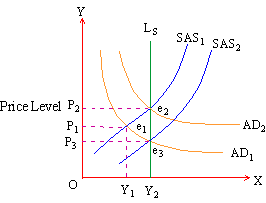|
(B) Fiscal Policy at work
i) During Unemployment: Fiscal policy has been strongly recommended by Keynes and his followers under the conditions of depression. Though the fiscal policy can take both expansionary and contractionary forms, it is the expansionary fiscal policy and deficit financing that has dominated the post Second World War period. It intends to maintain a high and growing size of the effective demand. Keynesians are of the view that only such policies can cure unemployment, stabilize the economy and help in maintaining high levels of output and employment. The classical opponents of Keynes however uphold the price and wage-cut policy that leaves out public intervention in economic activities. Those who follow the classical view also fear that government expenditure and its attempts to increase effective demand may cause inflation. Keynesians counter argue that if a choice is to be made between inflation and unemployment then the former should be preferred. Inflation is a lesser evil than unemployment. The classicists further state that without any government spending, natural full employment equilibrium can be established with the help of a price-wage cut in the long run after a lapse of time. But Keynes himself had made the witty statement: "In the long run all of us are dead." This suggests that even if long run equilibrium is possible with a cut in the wage-rate, it is not advisable to follow. Labor is an extremely perishable commodity. Every day in the workmanís life matters. It is improper to ask thousands or millions of workers to wait for few months or years before the economic situation can be improved and jobs can be made available. The controversy between the two view points can conveniently be explained with the help of a figure.

Figure 24
Level of Real Income / Employment
In figure 24 we find that levels of real income and employment have been shown on the horizontal axis and various price levels appear on the vertical axis. AD1 and AD2 are aggregate or effective demand curves and SAS1 and SAS2 are short run aggregate supply curves. The vertical line Y2e3 e2Ls is the long run supply curve. It stands for natural or full employment level of resources and output. Letís begin with initial demand and supply conditions along AD1 and SAS1. The two curves have intersected at point e1 which is an equilibrium position. At point e1 level of output (or real income) and employment is Y1and level of price is P1.
|
Index 7.1 Fiscal Policy
7.2
Banking
Chapter 8
|